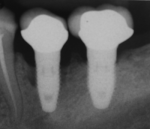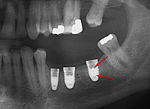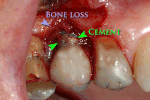dental implant lecture by DR,tarek al debakey in saudi arabia
A dental implant (also known as an endosseous implant or fixture) is a surgical component that interfaces with the bone of the jaw or skull to support a dental prosthesis such as a crown, bridge, denture, facial prosthesis or to act as an orthodontic anchor. The basis for modern dental implants is a biologic process called osseointegration
The primary use of dental implants is to support dental prosthetics. Modern dental implants make use of
A typical conventional implant consists of a titanium screw (resembling a tooth root) with a roughened or smooth surface. The majority of dental implants are made out of commercially pure titanium, which is available in four grades depending upon the amount of carbon, nitrogen, oxygen and iron
Planning for dental implants focuses on the general health condition of the patient, the local health condition of the mucous membranes and the jaws and the shape, size, and position of the bones of the jaws, adjacent and opposing teeth. There are few health conditions that absolutely preclude placing
Most implant systems have five basic steps for placement of each implant:
- Soft tissue reflection: An incision is made over the crest of bone, splitting the thicker attached
gingiva are pushed Flapless - Drilling at high speed: After reflecting the soft tissue, and using a surgical guide or stent as necessary, pilot holes are placed with precision drills at highly regulated speed to prevent burning or pressure necrosis of the bone.
- Drilling at low speed: The pilot hole is expanded by using progressively wider drills (typically between three and seven successive drilling steps, depending on implant width and length). Care is taken not to damage the
osteoblast - Placement of the implant: The implant screw is placed and can be self-tapping,[28](pp100–102)
otherwise at - Tissue adaptation: The
gingiva
Timing of implants after extraction of teeth
There are different approaches to placement extractionThe
- Immediate post-extraction implant placement.
- Delayed immediate post-extraction implant placement (two weeks to three months after extraction).
- Late implantation (three months or more after tooth extraction).
- Immediate loading procedure.
- Early loading (one week to twelve weeks).
- Delayed loading (over three months)
Healing time[
For an implant to become permanently stable, the body must grow bone to the surface of the implant (osseointegration). Based on this biologic osseointegration osseointegration was allowed
However, later research suggests that the initial stability of the implant in bone is a more important determinant of success of implant integration, rather than a certain period of healing time. As a result, the time allowed to heal is typically based on the density of bone the implant is placed in and the number of implants splinted together, rather than a uniform amount of time. When implants can withstand high torque (35 Ncm
Immediate placement
An increasingly common strategy to preserve bone and reduce treatment times includes
Additional surgical procedures
For an implant to osseointegrate thick healthy
Hard tissue (bone) reconstruction
Bone grafting is necessary when there is a lack of bone. While there are always new implant types, such as short implants, and techniques to allow compromise, a general treatment goal is to have a minimum of 10 mm in bone height, and 6 mm in width. Alternatively, bone defects are graded from A to D (A=10+ mm of bone, B=7–9 mm, C=4–6 mm and D=0–3 mm) where an implant's likelihood of osseointegrating is related
To achieve an adequate width and height of bone, various bone grafting techniques have been developed. The most frequently used is called guided bone graft augmentation where a defect is filled with either natural (harvested or autograft
Three common procedures are:
- The sinus lift
- Lateral alveolar augmentation (increase in the width of a site)
- Vertical alveolar augmentation (increase in the height of a site)
Other, more invasive procedures, also exist for larger bone defects including mobilization microvascular
Soft tissue (gingiva) reconstruction
The gingiva mucosa mucosa gingiva
When an adequate band of attached tissue is absent, it can be recreated with a soft tissue graft. There are four methods that can be used to transplant soft tissue. A roll of tissue adjacent to an implant (referred to as a palatal roll) can be moved towards the lip (buccal gingiva vascularized interpositional periosteal
Additionally, for an implant to look esthetic, a band of full, plump gingiva implant greate
Recovery
The prosthetic phase begins once the implant is well integrated (or has a reasonable assurance that it will integrate) and an abutment is in place to bring it through the mucosa osseointegration biomechanical
Single teeth, bridges and fixed dentures
An abutment is selected depending on the application. In many single crown on zirconia
The platform between the implant and the abutment can be flat (buttress) or conical fit. In conical fit abutments, the collar of the abutment sits inside the implant which gingival marginally flat-top
Regardless of the abutment material or technique, an impression of the abutment is then taken and a crown secured to the abutment with dental cement. Another variation on abutment/crown model to on
Prosthetic procedures for removable dentures[
When a removable denture is worn, retainers to hold the denture in place can be either custom made or "off-the-shelf" (stock) abutments. When custom retainers are used, four or more implant fixtures are placed occlusal
Alternatively, stock abutments are used to retain dentures using a male-adapter attached to the implant and a female adapter in the denture. Two common types of adapters are the ball-and-socket style retainer and the button-style adapter. These types of stock abutments allow movement of the denture, but enough retention to improve the quality of life for denture wearers, compared to conventional dentures.[42] Regardless of the type of adapter, the female portion of the adapter that is housed in the denture will require periodic replacement, however the number and adapter type does not seem to affect patient satisfaction with the prosthetic for various removable alternatives
Maintenance
After placement, implants gingiva if discolour irrigator
Risks and complications
During surgery
Placement of dental implants is a surgical procedure and carries the normal risks of surgery including osteotomy osseointegration
First six months
Primary implant stability
Primary implant stability refers to the stability of a dental implant immediately after implantation. The stability of the titanium screw implant in the patient's bone tissue post surgery may be non-invasively assessed using resonance frequency analysis. Sufficient initial stability may allow immediate loading with prostheticreconstruction
The relevance of primary implant stability decreases gradually with regrowth of bone tissue around the implant in the first weeks after surgery, leading to secondary stability. Secondary stability is different from the initial stabilization, because it results from the ongoing process of bone regrowth into the implant (osseointegration). When this healing process is complete, the initial mechanical stability becomes biological stability. Primary stability is critical to implantation success until bone regrowth maximizes mechanical and biological support of the implant. Regrowth usually occurs during the 3–4 weeks after implantation. Insufficient primary stability, or high initial implant mobility, can lead to failure.
Immediate post-operative risks
- Infection (pre-op antibiotics reduce the risk of implant failure by 33
percent but - Excessive bleeding
- Flap breakdown (less-than 5 percent))
Failure to integrate[
An implant is tested between 8 and 24 weeks to determine if it is integrated. There is significant variation in the criteria used to determine implant success, the most commonly cited criteria at the implant level are the absence of pain, mobility, infection, gingival bleeding, radiographic lucency or peri-implant bone loss greater than 1.5 mm
Dental implant success is related to operator skill, quality and quantity of the bone available at the site, and the patient's oral hygiene, but the most important factor is primary implant
Integration failure is rare, particularly if a dentist's or oral surgeon's instructions are followed closely by the patient. Immediate loading implants may have a higher rate of failure, potentially due to being loaded immediately after trauma or extraction, but the difference with proper care and maintenance is well within statistical variance for this type of procedure. More often, osseointegration to receive
Long term
The long-term complications that result from restoring teeth with implants relate, directly, to the risk factors of the patient and the technology. There are the risks associated with appearance including gingival biomechanical did such roots poor biomechanical Finally there
From these theoretical risks, derive the real world complications. Long-term failures are due to either loss of bone around the tooth and/or gingiva peri implantitis gingiva peri implantitis periimplantitis prophylaxis these implant
Criteria for the success of the implant supported dental prosthetic varies from study to study, but can be broadly classified into failures due to the implant, soft tissues or prosthetic components or a lack of satisfaction on the part of the patient. The most commonly cited criteria for success are function
The rates of complications vary by implant
Single crown
- Implant survival: 96.8 percent
- Crown survival: metal-ceramic: 95.4 percent; all-ceramic: 91.2 percent; cumulative rate of ceramic or acrylic veneer fracture: 4.5
percen - Peri-implantitis: 9.7
percenp percen - Peri-implant mucositis: 50
percen - Implant fracture: 0.14 percent]
- Screw or abutment loosening: 12.7 percent
- Screw or abutment fracture: 0.35 percent]
Fixed complete dentures]
- Progressive vertical bone
loss but percen - Failure after the first
year 5 at Incidence of veneer fracture at: -
- 5-year: 13.5]
to - 10-year: 51.9 percent (32.3 to 75.5 percent with a confidence interval at 95 percent)]
- 15-year: 66.6 percent (44.3 to 86.4 percent with a confidence interval at 95 percent)
- 5-year: 13.5]
-
- 10-year incidence of framework fracture: 6 percent (2.6 to 9.3 percent with a confidence interval at 95 percent)[
- 10-year incidence of esthetic deficiency: 6.1 percent (2.4 to 9.7 percent with a confidence interval at 95 percent)
prosthetic to
The most common complication being fracture or wear of the tooth structure, especially beyond ten years with fixed dental prostheses made of metal-ceramic having significantly higher ten-year survival compared those made of gold-acrylic.
Removable dentures (overdentures )
- Loosening of removable denture retention: 33 percent]
- Dentures needing to be relined or having a retentive clip fracture: 16 to 19
percen


















For further information, contact me
ReplyDelete